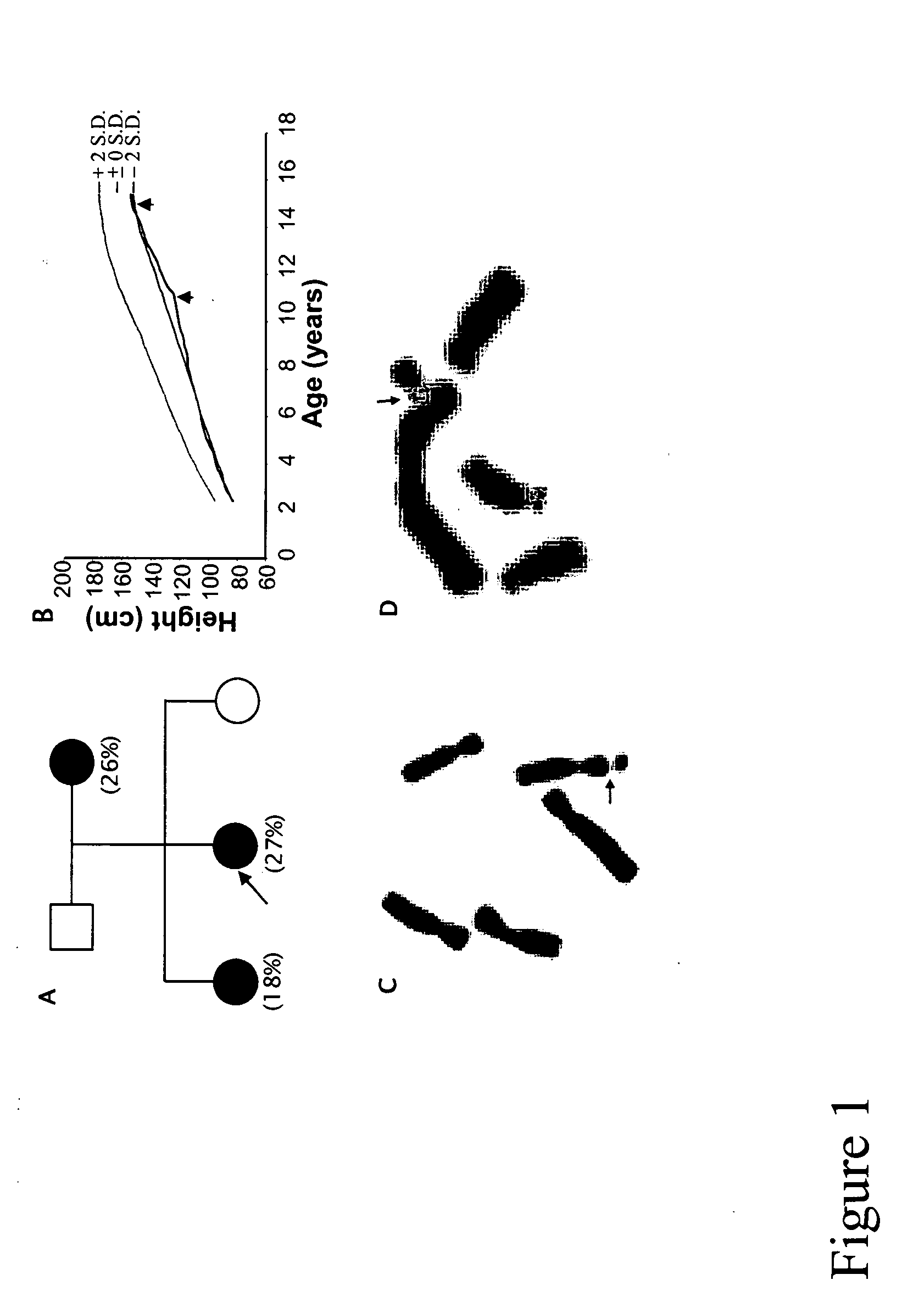Methods and reagents for predicting the likelihood of developing short stature caused by FRAXG
a technology of fraxg and likelihood, applied in the field of methods and reagents for predicting the likelihood of fraxg developing short stature, can solve the problems of not being able to identify candidate genes or genetic regions, and achieve the effect of diagnosing short stature in individuals
- Summary
- Abstract
- Description
- Claims
- Application Information
AI Technical Summary
Benefits of technology
Problems solved by technology
Method used
Image
Examples
example 1
Identification Mapping and Characterization of FRAXG: Case Study of a Finnish Family
[0087] The proband (i.e., the initial subject in a family to present a disorder who causes initiation of a genetic study on the family) was a Finnish girl of seven years old when she was brought to a physician's attention due to her short stature. At age 9.4 years, her weight was 21.6 kg and her height was 118.3 cm (3.2 standard deviations below the mean for that age). No other complaints were mentioned. No abnormal eating or sleeping habits were mentioned. No chronic fever, diarrhea, or chronic pain was complained of. The girl was delivered naturally without any incidents at 41 weeks of gestation. Her body weight and height (47 cm) were within normal range at birth. She was the second child of nonconsanguineous parents (FIG. 1A). Physical examinations were generally normal except her height. Her height was below the fifth percentile of her peers. The ratio of her upper body length over her lower li...
example 2
Identification of FRAXG, a Folate-Sensitive Fragile Site Located Close to the Border of Xp21 and Xp22 in the Finnish Family
[0088] This study was performed when a chromosome study of the proband was requested at age 9.4 years due to her unexplained short stature. Peripheral blood was drawn from the proband and other family members using standard techniques. Induction of FRAXG was carried out following the recommended procedures for the induction of rare, folate-sensitive fragile site (Jacky, P. B., Ahuja, Y. R., et al., 1991, Guidelines for the preparation and analysis of the fragile X chromosome in lymphocytes, Am J Med Genet 38(2-3):400-3). Briefly, cells present in the peripheral blood were cultured for four days after standard treatment as described by Verma and Babu, 1989, Human Chromosomes: Manual of Basic Techniques, p. 240. Metaphase spreads were prepared by standard techniques and stained by either Giemsa for solid staining or Trypsin-Giemsa for banding.
[0089] The results ...
example 3
Induction of FRAXG from the Proband's Lymphoblastoid Cell Line
[0090] Lymphoblastoid cell lines (LBCL) from all family members were established from peripheral lymphocytes. Two inducing conditions for RHFFS in LBCL were used. One is medium 199 (Gibco BRL) plus FudR at concentration of 10−6, 5×10−7 or 10−7 M for 24 or 48 hours. Another is medium 199 plus MTX at concentration of 10−7 M for 24 or 48 hours. As shown in FIG. 2, FRAXG was observed as both a chromatid break (Panel A) and non-staining gap (Panel B). Under the inducing conditions tested, medium 199 plus 10−7 M FudR gave the highest induction rate of FRAXG (5-7%). Compared to PBL, this is about 25% of that from fresh PBL. Successful induction of FRAXG in LBCLs not only confirmed the expression of this novel fragile site in the Finnish kindred, but also provided sufficient samples for the subsequent fine fluorescence in situ hybridization (FISH) mapping of FRAXG.
PUM
| Property | Measurement | Unit |
|---|---|---|
| Fraction | aaaaa | aaaaa |
| Fraction | aaaaa | aaaaa |
| Length | aaaaa | aaaaa |
Abstract
Description
Claims
Application Information
 Login to View More
Login to View More - R&D
- Intellectual Property
- Life Sciences
- Materials
- Tech Scout
- Unparalleled Data Quality
- Higher Quality Content
- 60% Fewer Hallucinations
Browse by: Latest US Patents, China's latest patents, Technical Efficacy Thesaurus, Application Domain, Technology Topic, Popular Technical Reports.
© 2025 PatSnap. All rights reserved.Legal|Privacy policy|Modern Slavery Act Transparency Statement|Sitemap|About US| Contact US: help@patsnap.com



